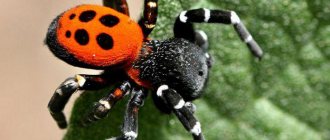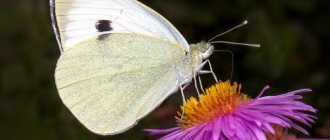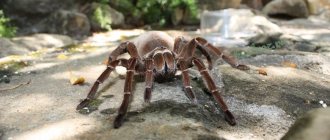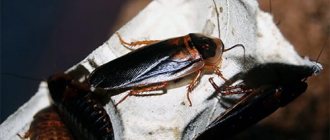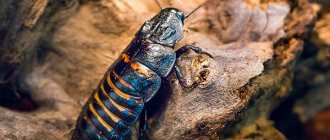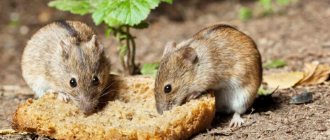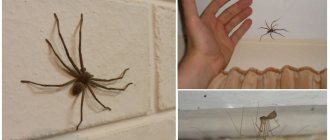You can watch a spider's meal for a long time. Feeding spiders is a truly fascinating spectacle. Seeing the victim, the spider rushes at it and instantly injects poison into the body. The poison immobilizes the prey, and the spider, slowly weaving it with a web, releases gastric juice into the prey and begins to eat. The feeding of spiders turns into a whole performance. But what should you feed a regular spider to ensure its long existence? How is feeding a tarantula spider different? To understand what to feed a spider at home, you need to understand what constitutes the diet of arthropods in their natural habitat.
Diet of house spiders
How often to feed a spider
Eating food every day is unnatural for spiders. Feeding your pet should happen no more than 1-2 times a week. It is also necessary to monitor the size of the abdomen; after eating the food, it should not grow more than 2 times. Otherwise, overeating threatens abdominal rupture and death.
If the spider refuses food, there is no need to sound the alarm. Temporary hunger strikes lasting a couple of weeks, or even a month, are completely normal.
What to feed a spider
The basis of your pet's diet should consist of food insects. Spider food is available in many pet stores.
It is better to create a diet for the spider from insects of a suitable size relative to the size of the pet itself. It is the choice of the spider owner to grow prey for your pet yourself or buy it from trusted places.
It is necessary to have a special container with water in the terrarium. The spider needs it in its diet every day, unlike food. Water should always be clean and fresh.
Nutrition method
Many people are interested in how spiders eat insects, small vertebrates and other creatures, or rather, how they catch the prey and what they then do with it. Arachnids are known to weave webs from spider webs, which they use for fishing. The predator itself sits on the central area of the net and waits until it catches an insect. But he determines its presence by the vibration or vibration of the web.
Some species of predators do not spin webs; they explore the surrounding area, wait, and then attack. Others may weave not nets, but funnels near a hole or shelter.
The behavior of predators may differ - some can envelop the prey in a web and wait until it stops moving, others attack it immediately. But initially, a toxic substance is injected into the trapped insect.
Spider nutrition has some features:
- they lack complete digestive organs. The food is digested from the outside, after which the insect absorbs the liquid mass through the mouth.
- Carnivores have no teeth in the oral cavity. They grind food using chelicerae, pedipalps similar to tentacles.
- Some spiders can only suck up liquid food, others crush the shell and bite through the skin.
- Digestion of amphibians and rodents takes longer. The predator eats a mouse, frog, or snake gradually, it turns the victim over, constantly injecting a new portion of saliva.
Preparing feed yourself
You can prepare food for your beloved pet yourself. This saves money and time for frequent trips to the pet store. It is not difficult to breed marbled cockroaches, which are a delicacy for spiders in their regular diet. You can grow a colony of cockroaches in a glass jar. You need to throw bark and cardboard at the bottom of the container and put 10-20 individuals there. Marbled cockroaches reproduce quickly and are not picky about food. You can feed them vegetable scraps, bread crumbs and small pieces of meat.
To prevent cockroaches from escaping, you should coat the edges of the jar with Vaseline. When selecting food for a spider’s diet, it is better to collect young cockroaches that have not yet acquired wings. Such victims are suitable for both an adult spider and a small growing pet.
Important tips for feeding spiders:
- You cannot leave the corpse of an insect in the terrarium if decomposition has occurred. Corpse poisons are extremely harmful to your pet.
- Feeding the spider immediately after molting is not advisable. Insects can harm a spider that has just survived its molt.
- It is necessary to immediately remove the remains of the spider's meal.
- It is not advisable to freeze food for further use. Many spiders will simply refuse stale food.
- If the insect turns out to be larger than the spider, you should cut it into pieces.
- If the spider refuses to eat, you need to crush the insect's head with a stone and leave it in the terrarium for a couple of hours. If more than 8 hours have passed and the spider has not touched the food, be sure to remove the corpse.
The key to a long and happy life for your pet is taking care of its diet. Myths that tarantulas should eat only vertebrates cannot be believed. Listening, or rather looking closely at the state of the spider, you need to feed it according to need, and under no circumstances overfeed it. Moderate nutrition, care for the cleanliness of the terrarium and frequent replacement of drinking water are to the taste of all domestic spiders on the planet.
What not to feed spiders
We have found out what spiders eat, but now it’s worth considering what food they should not give. Despite the fact that predators are omnivores, there is information that they can eat even small birds, but it is still worth taking a responsible approach to their diet.
It is not advisable to feed amphibians and rodents. Of course, they can consume these creatures, but health problems may arise afterwards. For example, after eating a small mouse or frog, your pet may experience indigestion and may eventually die.
Do not include domestic cockroaches in your spider's diet. These insects are nutritious and useful for predators, but there is still a chance that they are poisoned, and after the spider eats an insect with poison, it will quickly die or be sick for a long time. For this reason, you should not let your pet go hunting for this animal.
It is not recommended to use for feeding bugs that were caught on the street. The fact is that they can also be poisoned. Often, street dwellers carry dangerous diseases that can also affect spiders. If you are worried about your pet and do not want to lose it, you should not feed it this food.
If food supplies are depleted, and it is not possible to go to a pet store, then your pet can be fed with street insects. But they should be collected away from roads, preferably outside the city. Before feeding the creatures, you should carefully inspect and rinse.
You should not freeze them for future use, because some insects do not die when frozen, and the spider may not want to eat a stale product.
As for frogs, newborn mice, this food is difficult for spiders. They can use it for several days. During this time, it will have time to decompose in a warm terrarium and become filled with corpse poisons. Still, if you want to see how a predator will deal with an animal, you should make sure that it is healthy, and its size should not be larger than a spider.
It is not recommended to give your pets other predatory insects - scolopendras, mantises, and other spiders. They can attack your pet, and in the end it will not be clear who will act as food - the victim or the spider.
Spiders in the house: how to find the cause
Some people believe that spiders in the house are a harbinger of trouble. But there is another opinion - seeing a spider in the house is a sign of good or financial gain.
You can read about superstitions associated with spiders here.
There are two main reasons for the appearance of spiders in a person’s home:
- they become uncomfortable in the house, the weather deteriorates, and they look for a calmer and more comfortable place;
- there is enough food in the room to exist comfortably for a long period of time.
Dream Interpretation - Leather
Seeing leather as a material in a dream portends strengthening friendship and prosperity in love. Pieces and scraps of skin piled up in a heap portend good luck and happiness. Processing leather in a dream means no changes in the course of your business, tanning it is a residue from an unpleasant meeting, sewing something from it means accumulating wealth through frugality.
Leather clothing on someone is good luck in the game and in everything related to money. Being dressed in leather means you will be lucky in love. Seeing suede products in a dream means your charms will conquer any man. Safyan portends help from unexpected sources. Black or dirty skin is a sign of adultery. Cleaning or washing the skin means illness of loved ones.
If in a dream you focus your attention on human skin without any flaws, clean and beautiful, this means that in real life you will be the object of adoration of a prominent man. Smooth and silky skin to the touch - to the fulfillment of desires regarding the creative side of life
Old, loose and wrinkled skin indicates that you will safely reach old age. Sick skin - to wealth; skin with scratches, bruises and scars - to ill-gotten money. Torn and bleeding skin - to a rich groom and an imminent wedding. Being treated for skin diseases in a dream promises health and profit.
Seeing a blister from a burn on the skin is a sign of unexpected events in your personal life. An abscess on the skin means drinking in a fun company; boils mean trouble in the near future, insincerity of friends who are hiding something from you. Sores on the skin mean that the disease will undermine your strength and bring mental exhaustion.
Warts on the skin indicate a danger threatening your honor; you will have to stand up for yourself so as not to tarnish your good name and overcome all obstacles on the path to success. Skin covered with lichen means false hopes and disappointment in a loved one. Skin affected by smallpox means that an unexpected and rare disease awaits you, because of which all your plans will go down the drain.
Seeing skin worn away by leprosy means doing something that will bring concern not only to you personally, but to your entire family. Skin covered with a rash from scabies is a sign of fear of failure in a business that you have never done before. Scratching your skin to the point of ulcers, experiencing unbearable itching, means that in reality you will find yourself in bad company and get into a lot of trouble.
Seeing skin completely covered with moles means an addition to the family. A large birthmark on the skin portends twins. The skin of your face or hands dotted with freckles means you will experience a funny adventure in reality. Tanned skin means you will have a successful vacation; white and pale skin means frustration from an insult caused by a loved one. Seeing your skin as black as a black woman’s means that in real life you will be mistaken for someone else.
It personifies the parasitic influence on someone’s part or one’s own vampiric aspirations to capture the victim. Fighting a spider means conflicts with superiors or opposition to the mother’s care. Holding a spider in your hands means receiving a gift. The web is an invisible trap. The symbolic meaning of this creature is associated with the web with which he weaves the world.
Since the web of life and fate is woven by the divine spider, it is perceived as a kind of universal given, the grip of existence. In mythology, the universal mother is depicted in the form of a spider, as a weaver of fate. In dreams, a spider can indicate its own domineering mother or someone’s vampiric presence , forcing you to act according to a plan alien to you.
Where do spiders go in winter?
Arthropods adapt to the onset of cold weather in different ways. Spiders are unable to tolerate temperatures below 0 degrees due to tissue crystallization. Depending on this, spiders can sleep or die in winter.
Young cross spiders and “newborn” wasp spiders migrate on wind-blown spider webs in search of habitat on warm September days. Huddled in a crack in the bark of a tree, spiders sleep in winter.
Sexually mature parents of baby wasps end their life in the summer: the male - in the form of a “wife” dinner after mating, the female - after laying eggs. A similar situation occurs in adult crosses. Autumn is the mating season, when males go in search of females sitting in their web. After fertilization of the female, the male dies. The spider weaves a cocoon in which it lays eggs. Having hidden it in a secluded place (in the bark of trees, cracks in masonry), it also dies. In the spring, spiderlings emerge from the eggs, ready to weave webs.
Males and females of black widows do not survive until the cold weather. At the end of June, mating occurs, after which the female eats the “suitor”. Having laid up to 130 eggs in prepared cocoons, she hides them in lairs (mouse holes, crevices) entwined with dense cobwebs and dies. Spiders appear in September and live in a cocoon until April, eating each other. With the onset of stable heat, they go outside.
As for the species of black widows, spiders that were born in September spend the winter with them. In a warm cocoon left by a caring spider mother, they sleep until April. Spreading in search of habitats, they have arachnoid and venom-carrying apparatus. During mating at the end of June, the female karakurt eats the male. After laying eggs it dies.
Domestic arthropods may go into torpor with the onset of winter if the number of indoor parasites decreases sharply. Waking up before the onset of spring, they can feed on their relatives.
Rare species live in burrows and crevices
Predatory arthropods, whose life cycle exceeds a year, fall into torpor with the onset of cold weather. Species such as tarantulas live in the wild for 5 to 10 years. Helping them survive is the ability to go without food for a long time and the mild climate in their habitats. With the onset of cold weather, they burrow into their vertical burrows and hibernate until spring.
The edge hunter has a life expectancy of 2 years, until the age of mating. After breeding, they die in August. Immature individuals spend two winters in the mother's cocoon, attached to the grass on the shore, in a state of torpor.
Silverback spiders build their winter cocoons underwater
During the cold season, when rivers and lakes are frozen, the silverfish prepares winter housing. The spider controls the volume of the bell and the oxygen content in it. The air supply in such a cocoon is enough for 4-5 months. Nearby, the silverfish weaves the second and third mesh networks and fills them with air. This insurance allows you to overwinter without rising to the surface until warm days arrive.
Hiding in a mollusk shell
If there is no algae and nowhere to go, the water spider can use an abandoned mollusk shell instead of a cocoon. He fills it with air bubbles from the surface and covers it with thick nets instead of curtains. Such a house serves as reliable protection from large fish and crayfish.
They overwinter with young offspring (the female is eaten in the spring)
The black fathead spends its winter in a special way. With the onset of autumn, the mating period approaches, and the males go in search of females. Having carried out the necessary fertilization ritual, the male remains to live in the same burrow with the female. The fathead spider makes a cocoon for its offspring, where it soon lays eggs.
For 2 months, spiders guard the clutch in a cocoon. With the onset of spring, spiders appear. Spiders serve as food for them. By the end of summer there are 3 molts. Young spiders crawl out of their holes to find a home. After 2 moults they will become sexually mature and will look for a female. A male spider, whose life cycle is less than a year, dies by this time.
Diet in the natural environment
Spiders are classified as obligate predators, whose menu includes exclusively small vertebrates and insects . Arachnologists mention the only exception - Bagheera kiplingi, a jumping spider living in Central America.
Upon closer examination, Kipling's Bagheera is not 100% vegetarian: during the dry season, this spider (for lack of Vachellia acacia foliage and nectar) devours its relatives. In general, the ratio of plant and animal food in the diet of Bagheera kiplingi looks like 90% to 10%.
Hunting methods
They depend on the lifestyle, sedentary or nomadic. A wandering spider usually lies in wait for its victim or carefully creeps up to it, overtaking it with one or two or three jumps. Nomadic spiders prefer to envelop prey with their threads.
Sedentary spiders do not run after the victim, but wait until it wanders into a skillfully woven net. These can be either simple signal threads or sophisticated (large in area) networks stretched to the observation post of their owner.
This is interesting! Not all hunters entangle their victims with webs: some (for example, Tegenaria Domestica) simply wait for the insect’s body to soften to the desired condition. Sometimes the spider releases its prey. This happens in two cases: if it is too large or has a strong smell (bug).
The spider kills prey with a toxin concentrated in poisonous glands, which are located in the chelicerae or (as in Araneomorphae) in the cephalothorax cavity.
The spiral muscles surrounding the glands contract at the right moment, and the poison reaches its destination through a hole at the tip of the claw-like jaws. Small insects die almost immediately, while larger ones continue to convulse for some time.
Hunting objects
For the most part, these are insects of suitable size. Spiders that weave nets more often catch all flying creatures, especially dipterans.
The species “assortment” of living creatures is determined by habitat and season. Spiders that live in burrows and on the soil surface eat mainly beetles and orthoptera, not disdaining, however, snails and earthworms. Spiders from the family Mimetidae target spiders of other species and ants.
Argyroneta, a water spider, specializes in aquatic insect larvae, fish fry and crustaceans. Spiders from the genus Dolomedes, which inhabit wet meadows and swamps, eat approximately the same thing (small fish, larvae and tadpoles).
The most interesting “dishes” are included in the menu of tarantula spiders:
- small birds;
- small rodents;
- arachnids;
- insects;
- fish;
- amphibians.
Young snakes often appear on the table of the Brazilian tarantula Grammostola, which the spider devours in huge quantities.
Nutrition method
It has been proven that all arthropods demonstrate an arachnid (extraintestinal) type of nutrition. The spider has everything adapted for consuming liquid food, from the filtering device of the pre-oral cavity and pharynx, the narrowed esophagus and ending with a powerful sucking stomach.
Important! Having killed the victim, the spider tears and crushes it with its jaws, releasing digestive juice inside, designed to dissolve the insides of the insect.
At the same time, the spider sucks up the protruding liquid, alternating between eating and injecting juice. The spider does not forget to turn the corpse over, processing it from all sides until it turns into a dried mummy.
Spiders that attack insects with hard cover (for example, beetles) pierce their articular membrane with chelicerae, usually between the chest and head. Digestive juice is injected into this wound, and the softened contents are sucked out from there.

